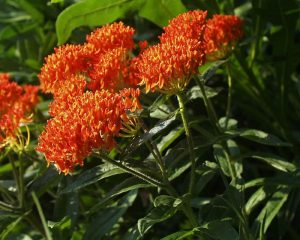The Perennial Plant Association has named butterfly milkweed (Asclepias tuberosa), as its 2017 Perennial Plant of the Year. With much focus on pollinator habitat these days, butterfly milkweed is a terrific selection. Butterfly milkweed flowers play host to a wide range of butterflies, and milkweed foliage is the food source for monarch butterfly caterpillars. Bees, wasps and other insects are also frequent visitors.
Butterfly milkweed is native to much of the continental United States and is hardy to U.S. Department of Agriculture plant hardiness zones 4-9. This species thrives best in full sun and well-drained soil and is drought tolerant. Plants reach about 2-3 feet tall with a similar spread. The bright orange/reddish-yellow flower clusters bloom throughout much of the summer. Elongated seed pods develop from the flowers and ripen to release numerous seeds with long silky hairs that aid seed dispersal. Pods should be cut back before they open to prevent unwanted selfseeding.
The Perennial Plant Association selects a different perennial plant each year to promote throughout the nursery and gardening industry. PPA members nominate plants based on several criteria, including low maintenance needs, adaptability to a wide range of climates, pest and disease resistance, wide availability, multiple seasons of interest and ease of propagation. A selection committee then narrows the field to three or four choices from which the members cast their votes. For more information on the Perennial of the Year program, see http://www.perennialplant.org/
Previous PPA Perennial Plant of the Year winners:
- 2016 Anemone × hybrida ‘Honorine Jobert’ (windflower)
- 2015 Geranium ‘Biokova’ (dwarf cranesbill, hardy geranium)
- 2014 Panicum virgatum ‘Northwind’ (tall switch grass)
- 2013 Polygonatum odoratum var. variegatum (Solomon’s seal)
- 2012 Brunnera macrophylla ‘Jack Frost’ (Siberian bugloss)
- 2011 Amsonia hubrichtii (blue star)
- 2010 Baptisia australis (blue false indigo)
- 2009 Hakonechloa macra ‘Aureola’ (Japanese forest grass)
- 2008 Geranium ‘Rozanne’ (cranesbill, hardy geranium)
- 2007 Nepeta racemosa ‘Walker’s Low’ (catmint)
- 2006 Dianthus ‘Feuerhexe’ (aka ‘Firewitch’) (cheddar pink)
- 2005 Helleborus x hybridus (hellebore, Lenten rose)
- 2004 Athyrium niponicum var. pictum (Japanese painted fern)
- 2003 Leucanthemum x superbum ‘Becky’ (shasta daisy)
- 2002 Phlox paniculata ‘David’ (garden phlox)
- 2001 Calamagrostis x acutiflora ‘Karl Foerster’ (feather reed grass)
- 2000 Scabiosa ‘Butterfly Blue’ (pincushion flower)
- 1999 Rudbeckia fulgida var. sullivantii ‘Goldsturm’ (black-eyed Susan)
- 1998 Echinacea purpurea ‘Magnus’ (purple coneflower)
- 1997 Salvia x sylvestris ‘Mainacht’ (aka ‘May Night’ ) (wood sage)
- 1996 Penstemon digitalis ‘Husker Red’ (beardtongue)
- 1995 Perovskia atriplicifolia (Russian sage)
- 1994 Astilbe ‘Sprite’ (dwarf astilbe)
- 1993 Veronica ‘Sunny Border Blue’ (speedwell)
- 1992 Coreopsis verticillata ‘Moonbeam’ (threadleaf coreopsis)
- 1991 Heuchera micrantha var. diversifolia ‘Palace Purple’ (coral bells)
- 1990 Phlox stolonifera (creeping phlox)
